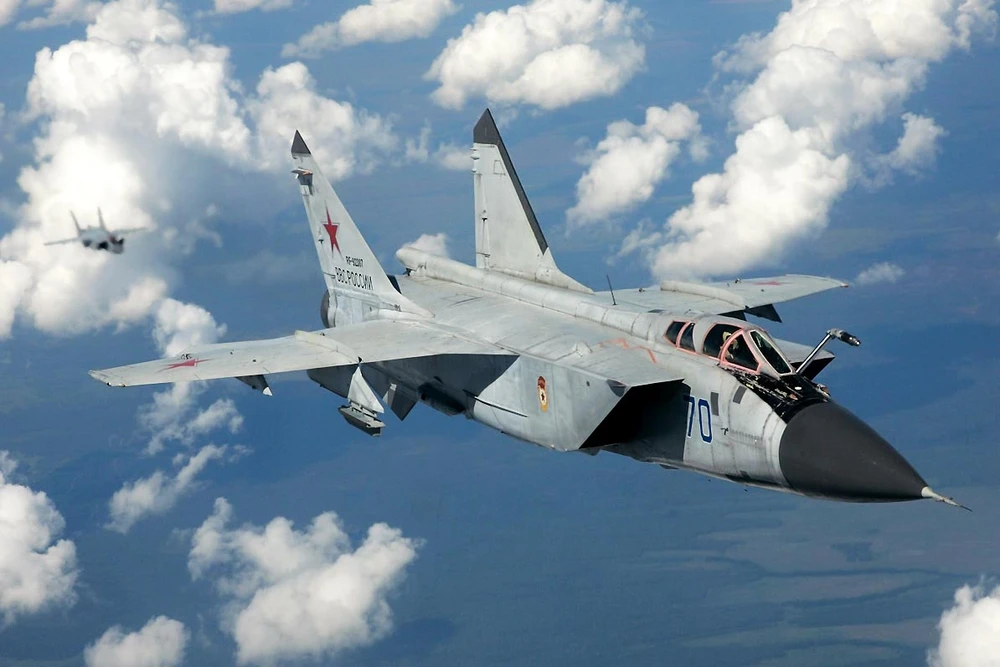The MiG-31, also known as the “Foxhound,” is one of Russia’s most formidable aircraft, striking fear in the hearts of adversaries and causing deep concern for Ukraine. Nicknamed “the beast” for its power and capabilities, the MiG-31 is not just a relic of the Cold War but a modernized threat in the skies, embodying the might of Russian aerospace engineering. As tensions between Russia and Ukraine escalate, the presence of the MiG-31 in the conflict zone is a significant cause for alarm. But what exactly makes this aircraft so terrifying?
A Speed Demon with No Equal
The MiG-31 is a supersonic interceptor that can reach speeds of up to Mach 2.83, making it one of the fastest combat jets in the world. This incredible speed allows it to intercept and engage enemy aircraft before they even realize they are being targeted. For Ukraine, this means that their air defenses and fighter jets could be outmatched and outpaced, leaving them vulnerable to swift and decisive attacks. The ability of the MiG-31 to patrol vast areas of airspace quickly and efficiently gives Russia a strategic advantage, particularly in a conflict where air superiority could determine the outcome.

Long-Range Killer
One of the most frightening aspects of the MiG-31 is its long-range capability. Equipped with the R-33 and R-37 long-range air-to-air missiles, the MiG-31 can engage targets at distances of up to 300 kilometers. This allows it to destroy enemy aircraft long before they come within striking range. For Ukraine, whose air force primarily relies on older Soviet-era aircraft, this range is a significant disadvantage. The MiG-31 can effectively neutralize Ukrainian air assets from a safe distance, making it difficult for Ukrainian pilots to even engage in combat.
Advanced Radar Systems
The MiG-31 is not just about speed and firepower; it is also equipped with advanced radar systems that make it a formidable hunter in the skies. The Zaslon-M radar system, for instance, is capable of tracking up to 24 targets simultaneously and can engage six of them at once. This radar has a detection range of up to 400 kilometers, meaning the MiG-31 can spot enemy aircraft long before they can detect it. This technological edge puts Ukraine’s air force at a severe disadvantage, as their older radar systems may struggle to compete with the MiG-31’s advanced capabilities.

Multi-Role Capabilities
While the MiG-31 is primarily known as an interceptor, it has been modernized to perform a variety of roles, including ground attack and reconnaissance. This versatility makes it a valuable asset in any conflict, capable of adapting to different missions as the situation demands. For Ukraine, this means that the MiG-31 could be used not only to establish air superiority but also to strike ground targets and gather intelligence. The aircraft’s ability to operate in all weather conditions and at any time of day further enhances its threat level, making it a constant presence in the skies.

Psychological Impact
Beyond its physical capabilities, the MiG-31 carries a psychological impact. Known for its intimidating size and reputation as a “beast,” the mere presence of the MiG-31 can have a demoralizing effect on opposing forces. For Ukrainian pilots, facing such a formidable adversary can be daunting, especially knowing that the MiG-31 has been involved in numerous successful operations throughout its service history. This psychological edge is a crucial factor in modern warfare, where morale and perception can influence the outcome of engagements.
The Implications for Ukraine
For Ukraine, the presence of the MiG-31 in the conflict zone is a stark reminder of Russia’s military superiority in the air. The capabilities of the MiG-31 make it a significant threat to Ukrainian air and ground forces, complicating any efforts to defend against Russian air operations. As the conflict continues, Ukraine must find ways to counter this “beast” in the skies, whether through advanced air defense systems, strategic alliances, or unconventional tactics.
In conclusion, the MiG-31’s speed, range, advanced technology, and multi-role capabilities make it a fearsome opponent in the skies, earning its reputation as a “beast.” For Ukraine, the challenge is not just in matching the MiG-31’s capabilities but in finding ways to neutralize its threat in a conflict where air superiority could be the key to victory. As tensions rise, the MiG-31 remains a symbol of Russian power and a source of anxiety for Ukraine and its allies.





